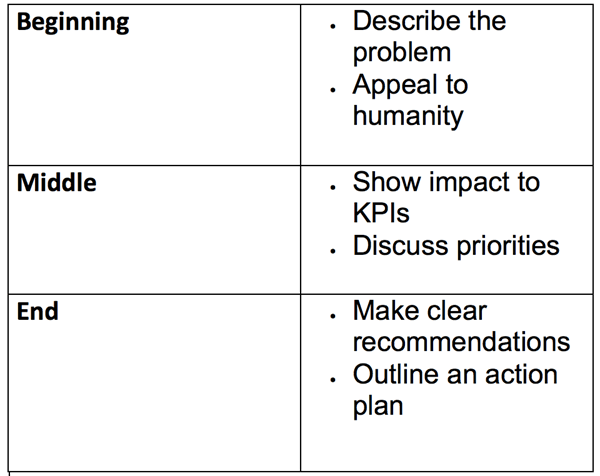Using AIM to Tell Better Stories and Move the Needle

Class tales like Little Red Riding Hood can teach us a lot about telling better stories in our organizations. Photo Credit: PublicDomainPictures.net via CC License
I wrote this article with my colleague Ruth McCullen. She’s the Director of Client Analytics at FCR. This article was originally published on the ICMI blog on May 18, 2017. Click here to read the original.
Can you relate to this scenario? The call queue in your contact center goes from zero to sixty in a matter of seconds — great for a BMW but not for a call queue. After a bit of investigation, you find a bug in the system. You quickly rush over to someone in your IT department to alert them of the issue and say something like, “Our call queue is blowing up right now. You need to fix this at once!” Your face is bright red and a few tears might even be shed depending on the severity of the issue.
The IT team member you bear your soul to coolly looks at you, and without flinching, informs you that they already have their marching orders for the day. Your problem will either have to wait or you’ll have to come up with a compelling argument as to why your issue deserves to be at the front of the line.
How about this scenario? You have the rare opportunity to make a big impression with members of the C-suite. You’re seeking their approval for an increase in budget to add additional members to the customer service team with the belief that improved service levels will increase customer satisfaction. Your PowerPoint presentation is packed with charts displaying monthly call volume, average handle time, hold time, and a variety of other stats.
It’s a glorified data dump, and if you’re lucky to not get abruptly cut off by a busy executive, you’ll likely leave that meeting without the approval you seek.
Telling Stories
If either of these scenarios sounds familiar, you need to practice telling better stories. Long before the printing press, dip pens, and hieroglyphics was a rich oral tradition — one where human beings passed information and history through spoken word. Great storytellers have the ability to persuade, teach, and move people to action.
Applied in a business context, stories are often the difference between getting what you need or going without. And your success and the success of your team largely depends on this. Have we got your attention?
The fantastic news is that we have a simple, easy way to help you tell better stories in your workplace and move the needle. It’s called A.I.M.
- Audience
- Intent
- Message
Audience
The first step to A.I.M. is to know your audience. Effective storytelling will always contain some combination of story and data. If we learn anything from Goldilocks and the Three Bears, we learn that it must contain not too much, not too little, but just the right amount of information. How do we know what that just right amount is? It totally depends on your audience. Whether it’s a member of the C-suite, a highly technical IT person, or your frontline staff, your presentation will vary widely.
Take a moment to think about all of the different people and roles in your organization that you interact with regularly. Your list might include senior executives, management, supervisors, frontline agents, and even customers. Next, look at the various metrics that you track on a regular basis and evaluate which ones each role cares most about. Your frontline staff might care about their individual metrics like quality and handle time while senior leadership cares more about the overall cost of your department and customer satisfaction metrics.
Intent
The next step is to be very clear on your intent for the interaction. What do you want and need from the other person or group you’re presenting to? Think about the case of the Three Little Pigs. The third pig was the only one who seemingly knew that the ultimate goal was to be safe from the big bad wolf. He’s the only one who planned accordingly by building his house out of brick.
Like the pigs, tie your intent this back to the mission of your organization. How will getting what you’re asking for help your organization achieve their greater goals? If you can tie into this, you will be much more successful in inspiring action from your audience.
Message
Once you are clear on your audience and intent, it’s time to put it all together into a compelling story. We recommend using the classic story archetype to structure the presentation, which for lack of better terminology, involves a beginning, a middle, and an end.
The story of Little Red Riding Hood is a great way to illustrate this. In the beginning, Red’s grandmother is sick so she embarks on a journey to take her a basket of goodies. In the middle, she encounters a wolf and the action rises to the point where she runs away from the wolf. The woodcutter ultimately makes the wolf go away forever. Finally, in the end, she’s reunited with her grandmother, they enjoy the goodies, and health is restored.
As you think about this in the context of your presentation, here’s a chart illustrating key elements for each section:

As you are weaving your data into the presentation, be sure to share the impacts to KPIs (key performance indicators) that your audience will care about. For example, rather than talking about a 3:45 average handle time, talk about where it lies in relation to the overall goal. You might say that average handle time is above goal by 8%.
Conclusions
By being clear about who your audience is, knowing your intent, and then crafting your message to include the perfect blend of story and data, you will tell better stories and better achieve the mission of your organization.